It’s no secret that film has had a significant revival throughout the chaos that was, and still is, COVID-19. Isolation, forced or otherwise, has caused many to take to new hobbies or rekindle long standing ones. Primarily ones that are solitary, like photography.
This is a fantastic boon for those of us already in the hobby, but with global film shortages and an increasing demand for gear (read: film and gear is getting more expensive), what options are available for those of us starting out?
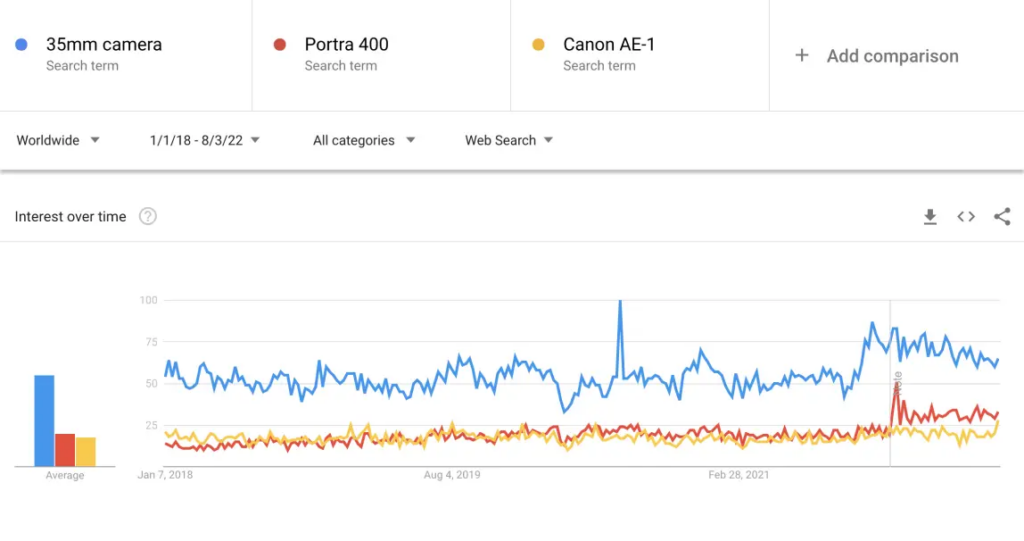
Google trends showing the increasing interest in 35mm photography since 2018. Get an up-to-date graph here
The Usual Suspect
The Canon AE-1 was a landslide product introduced in 1976, during a time of fierce competition between major Japanese camera manufacturers. The AE-1 marked the first time a microcontroller was embedded into a film camera. This was a triumph, as it gave the general public their first shutter priority camera* (see correction at bottom). A combination of affordability, ease of use, and a massive marketing campaign allowed Canon to sell over 5 million examples during the total product life of the AE-1 and its derivatives. Of course Nikon – the market leader – and Olympus swiftly introduced similar products like the Nikon FE and Olympus OM-10; attempting to stifle the flow of AE-1s, but the damage was done.
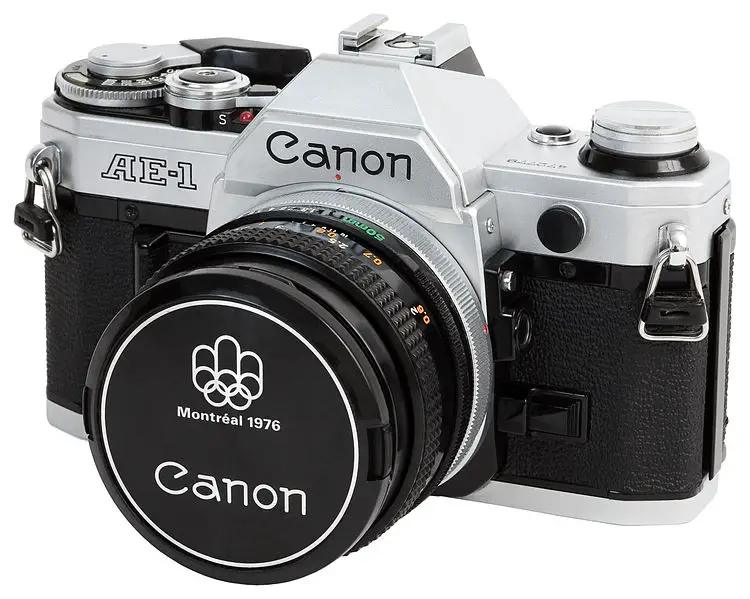
Flash forward to 2022. The AE-1 is now a ‘vintage’, mass produced, consumer camera that has become ‘the thing to have;’ to be seen with or to use. This makes no sense, as the increased attention has artificially inflated the price of a mass-produced, mediocre product (insert your Rolex joke here). All things considered, this should be an accessible product given the quantities produced.
Canon AE-1 advertisement. “So advanced – it’s simple.” Late 1970s. Copyright Canon Inc.
The 2020+ problem
The AE-1 has mass appeal, reinforced by word of mouth (parents, relatives, friends) or by my fellow experts on Youtube, Reddit, or what have you. This has caused the camera to go through a sort of hyperinflation, which far exceeds the actual value which it deserves.
So, what of the other manufacturers? Nikon makes a fantastic camera but their prices have also skyrocketed, making things like the FE, FA and FG harder to afford for the beginner. The Pentax K1000 is also a great performer, but it has also shot-up dramatically in price (and we have no idea why). Looking further afield, we see the often forgotten Olympus.
The Olympus OM-System
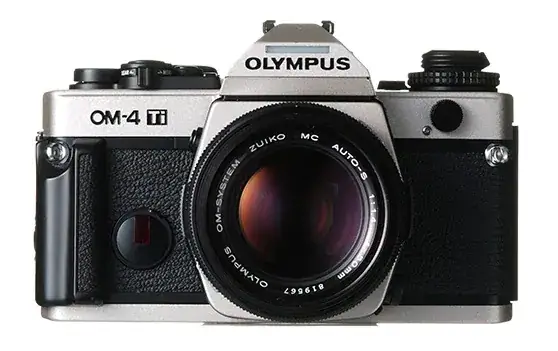
Olympus’ OM-System was introduced in the early 1970s with the OM-1, a professional system camera. The philosophy of this system has been recounted elsewhere, but its primary focus was compactness, ergonomics, and weight. This philosophy meant that Olympus delivered one of the smallest and lightest professional SLR packages, with left-field controls; the shutter control dial is on the lens bayonet and the aperture control is located at the end of the lens. Shock, horror!
Yet in the context of the OM-System, this makes sense. The camera bodies and lenses are incredibly small, and the controls are easily manipulated with a single hand while peering through the viewfinder. With the success of the OM-1 and later OM-2, consumer models followed shortly thereafter. The consumer models are denoted by double-digit numbers – OM-10, OM-20, and so forth.
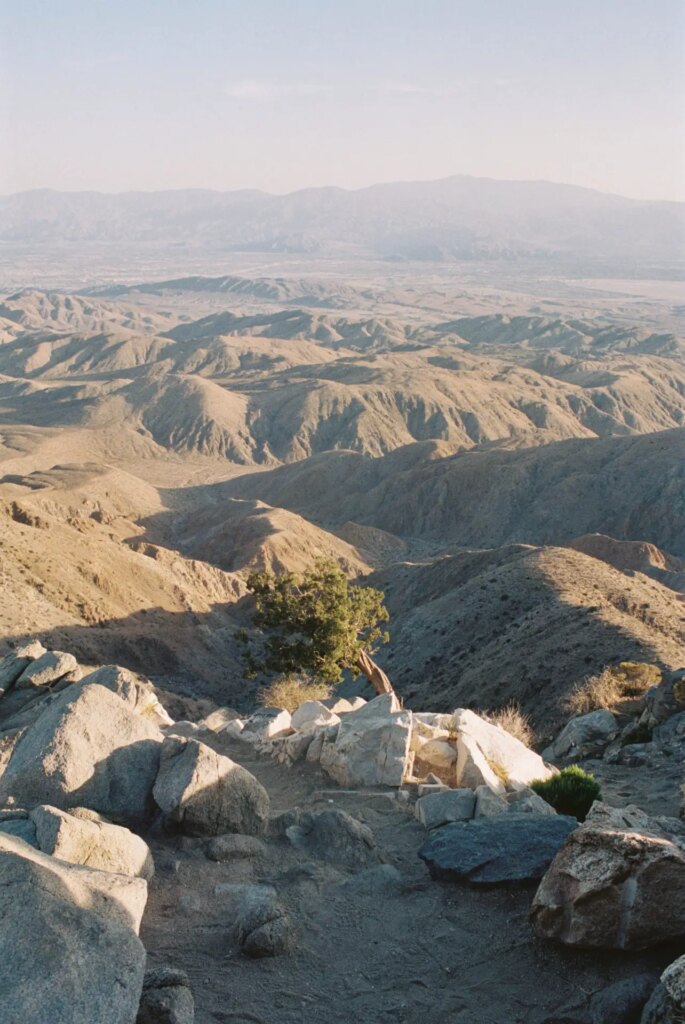
In today’s market the OM-System is somewhat of an open secret among the film photography community. Here’s a robust, compact system, with excellent glass, and affordable prices. Great, but what’s the catch? Supply. Canon and Nikon pumped out millions of lenses and bodies and Olympus simply couldn’t match that; at the time of writing, there are 39000 “Nikon Nikkor” lenses listed on eBay; 17000 ‘Canon FD’; and 2800 ‘Olympus OM Zuiko’ lenses listed.
Zuiko Lenses
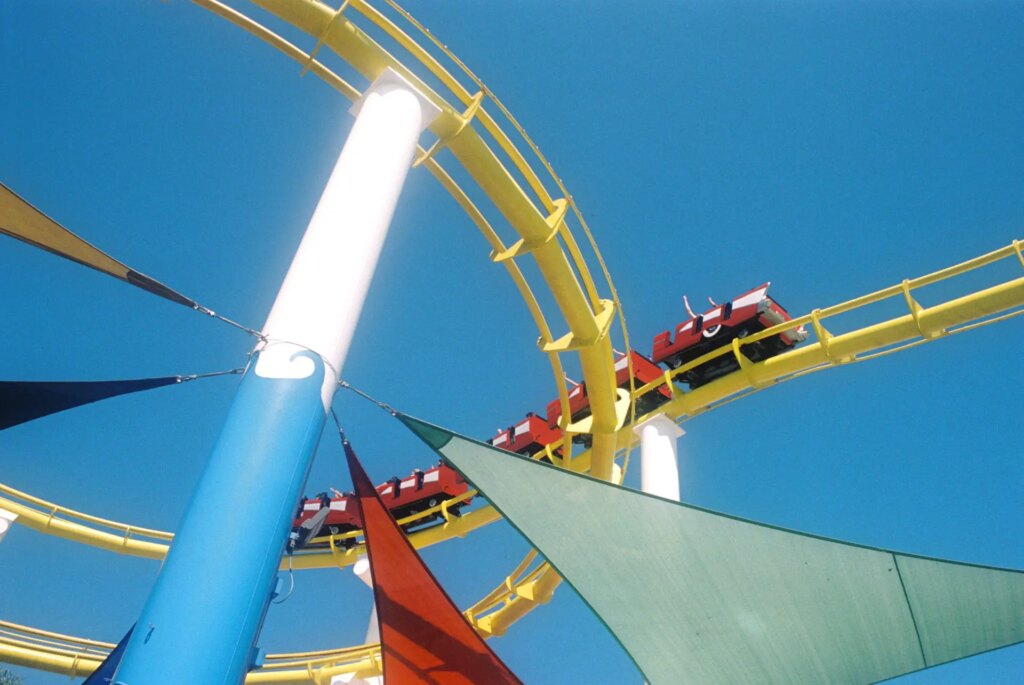
Out of that smaller selection, we have an easily understood lens system with significant resolving power. The bread and butter lenses are the primes – all of them are great. The ‘pro-level’ lenses are slightly larger in size with increased contrast, and have a maximum aperture of f/2. That’s it. The kit lens was a prime 50mm f/1.8, which is a great lens and often comes attached to camera bodies.
But what about automation? That was the second biggest strength of the original Canon AE-1 (the first being cost), so how does that compare?.The OM-System’s automation is aperture priority with exposure compensation of -2 to +2. Pretty standard fare for the time. Some models also came with a Program mode, like Canon’s AE-1 Program.

Yet, that’s not what draws many to it; it’s the lightmeter. Olympus introduced off-the-film metering (OTF) with the OM-2, which was unheard of at the time. OTF metering allowed the camera to continue to monitor the light hitting the film during longer exposures and vary the exposure depending on the changes in light. This culminated in cameras equipped with OTF Spot Metering like the OM-2SP, OM-3(Ti), and the top-of-the-line OM-4Ti. This is your replacement AE-1.
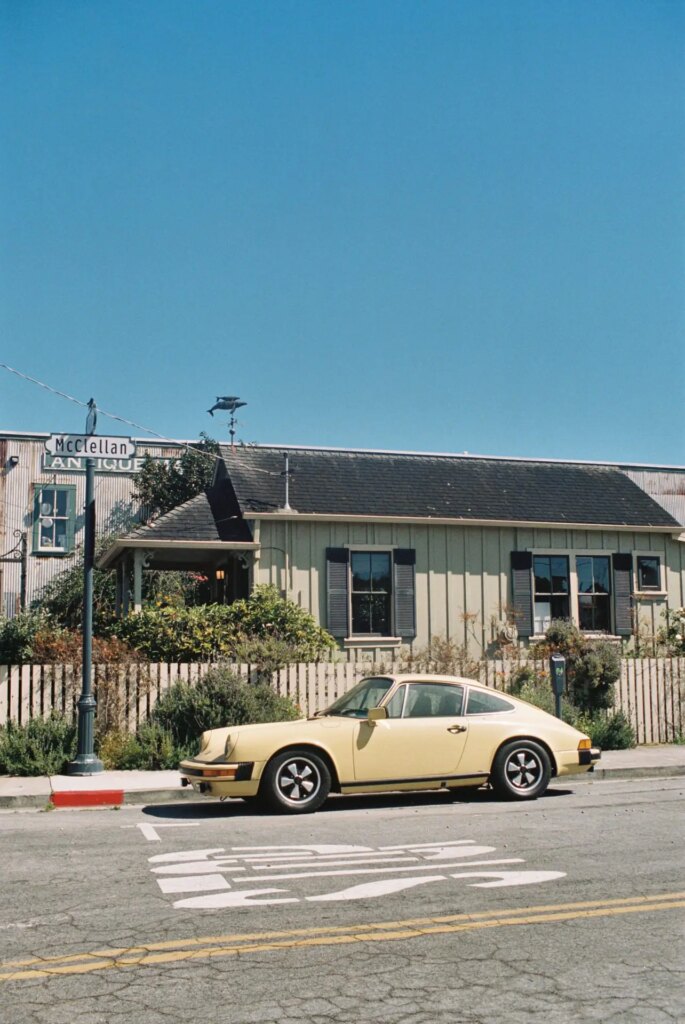
The OM-4 was introduced in 1983 but was quickly succeeded by the OM-4Ti in 1986 (OM-4Ti’s were branded OM-4T in the USA); this included an upgrade to titanium top and bottom covers and revised circuitry. The original OM-4 ate batteries, but the OM-4Ti does not suffer the same fate. The camera’s biggest it-factor was the multi-spot meter; you can take up to 8 spot readings in your scene and the camera will average out the correct exposure. Naturally you can measure the same spot multiple times to create a bias towards a certain exposure.
Olympus OM-4 advertisement. “Norman Rockwell” Mid 1980s. Copyright Olympus Corporation.
Of course the automatic full-frame metering mode is acceptable, but if you do not use the spot-metering system, then I would consider other offerings within the OM-System.
The Breakdown
So, why should you buy an OM-4Ti over a Canon AE-1? Let’s break that down.
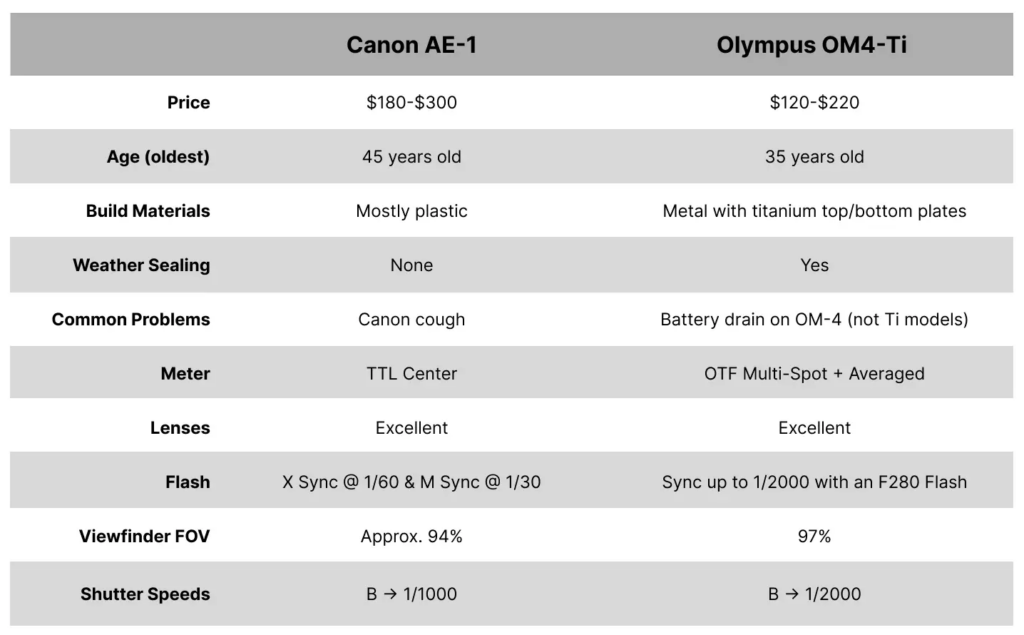
For the similar price of a consumer product AE-1, you could buy a professional OM-4Ti and a handful of lenses. The oldest AE-1s are 45 years old, whereas the oldest OM-4Tis are 35; production stopped in 2003. I recognise that this doesn’t account for the emotional factor of being seen with a trending item, but if you’re reading this, that’s likely a secondary consideration.
Unless you’re one of the lucky ones with a bequeathed AE-1, you should avoid these plastic cameras. In 2022 these cameras are over hyped and overpriced.
The OM-4Ti is a great performer and any camera within the OM-System provides a viable alternative to usual recommendations. I’ve owned an OM-4Ti for a decade, and in that time many cameras have come and gone. The OM-4Ti has remained through all of it.
You can see some of my photography on instagram: @wmaw
*Update August 22, 20:08 CEST: A reader has corrected me that the first shutter priority camera was made by Konica, the Auto-Reflex, in 1965.
Share this post:









Comments
Steve Curzon on AE-1 vs. OM4 – A Viable Alternative to Usual Recommendations – By Michael Allan-Wood
Comment posted: 22/08/2022
Neil on AE-1 vs. OM4 – A Viable Alternative to Usual Recommendations – By Michael Allan-Wood
Comment posted: 22/08/2022
John Bennett on AE-1 vs. OM4 – A Viable Alternative to Usual Recommendations – By Michael Allan-Wood
Comment posted: 22/08/2022
OM lenses are amazing and affordable,
*The OM-1N has a few improvements that make it worth choosing over the original OM-1.
mike on AE-1 vs. OM4 – A Viable Alternative to Usual Recommendations – By Michael Allan-Wood
Comment posted: 22/08/2022
Bill on AE-1 vs. OM4 – A Viable Alternative to Usual Recommendations – By Michael Allan-Wood
Comment posted: 22/08/2022
jason gold on AE-1 vs. OM4 – A Viable Alternative to Usual Recommendations – By Michael Allan-Wood
Comment posted: 22/08/2022
My life with Olympus is spoilt by reliability issues when they were launched. Lived in a temperate climate, no humidity. Now in Canada, Mr. Winter exterminates battery. Battery is a plural word!
Note: If you also use Leica-M film bodies all controls are very similar! Read instructions to open battery door! There is/was a key. Flash shoe cover! and Rolex, I hated working on them. Overpriced tractor design.
Patrick J. Cicalo on AE-1 vs. OM4 – A Viable Alternative to Usual Recommendations – By Michael Allan-Wood
Comment posted: 22/08/2022
Ted on AE-1 vs. OM4 – A Viable Alternative to Usual Recommendations – By Michael Allan-Wood
Comment posted: 22/08/2022
Ken on AE-1 vs. OM4 – A Viable Alternative to Usual Recommendations – By Michael Allan-Wood
Comment posted: 22/08/2022
Comment posted: 22/08/2022
davesurrey on AE-1 vs. OM4 – A Viable Alternative to Usual Recommendations – By Michael Allan-Wood
Comment posted: 22/08/2022
I left the OM4 and the even more expensive OM3 alone as I prefer the beauty of the OM1 in its simplicity and the OM2 is just so easy to use.
Funnily, even though I have several Olympus compacts and rangefinders eg the 35SP the Trip35 and the 35RD I never went to Oly for digital
davesurrey on AE-1 vs. OM4 – A Viable Alternative to Usual Recommendations – By Michael Allan-Wood
Comment posted: 22/08/2022
In fact it looked the other way. But that's the UK marketplace. Other sites and markets may vary.
Dan Castelli on AE-1 vs. OM4 – A Viable Alternative to Usual Recommendations – By Michael Allan-Wood
Comment posted: 22/08/2022
I’m retired, this my income is limited. I’m a homeowner, we both own our cars. These require maintenance, sometimes repair & upgrades. Or, to put it another way, money.
My point is that I must carefully spend funds on my photography. I replace as needed, not expand my armamentarium. This is not uncommon for my fellow retirees.
Some cameras my be inexpensive, so people buy to replace rather than repair. My approach was to buy a well crafted piece of equipment, and repair or CLA as needed. My lens selection is clustered around primes. I’m closer to a street discipline rather than a nature discipline.
I’ve been involved in photography for 60 years. The AE-1 pulled thousands into a new hobby. But, thousands abandoned the hobby for other pursuits. The OM pro line was aimed for pro photographers. They were not well build for the rigors of pro use. I once saw a UPI photographer kick his bag of OM equipment across a press room floor because is was so prone to break down.
Today prices are hyper inflated (like housing & gas.) look for gear that is robust, can be easily repaired and offers an extensive lens & accessory market. These observation are based on a hobby budget that is part of total living expenses.
Charles Detheridge on AE-1 vs. OM4 – A Viable Alternative to Usual Recommendations – By Michael Allan-Wood
Comment posted: 22/08/2022
, The Covid lockdown!
To my amazement I found during "lockdown one" people on eBay were THEN selling off their 35 mm cameras and lenses for stupid prices-stupid as in low! I also Found that film was still available (at that time, I was still learning, via Amazon) so I started rebuilding my original Olympus kit. Started with an OM-10 and a Zuiko prime lens sourced separately on Ebay . Including the OM-10 Manual Adaptor......£40. ......and it works. Not long after........the camera I'd dreamed of ..... OM-2, slightly worn, like me, 30 quid!!
Since then Olympus has ruled, with only a couple of aberrations - an American Argus "brick" and a Praktica (Same brand I started with, 40 years ago) with EDC lens set....... ???? . I'll never be an "Amateur Photographer", but I'm happy snapping!
David Hill on AE-1 vs. OM4 – A Viable Alternative to Usual Recommendations – By Michael Allan-Wood
Comment posted: 22/08/2022
Bill Watts on AE-1 vs. OM4 – A Viable Alternative to Usual Recommendations – By Michael Allan-Wood
Comment posted: 23/08/2022
I would recommend an OM series camera to anyone starting out in photography. The "non-standard" positioning of the speed selector and aperture ring appear to me, at least, to be a superior ergonomic arrangement as they can be operated with a single hand without taking the camera from the eye.
Leon on AE-1 vs. OM4 – A Viable Alternative to Usual Recommendations – By Michael Allan-Wood
Comment posted: 24/08/2022
Lee on AE-1 vs. OM4 – A Viable Alternative to Usual Recommendations – By Michael Allan-Wood
Comment posted: 24/08/2022
There's also the Canon A-1, which I think it the best option among all the Canon A-series variants because it combines all the autoexposure modes, including full program mode, into a single camera. I personally have an A-1, inherited from my mother, and I very much enjoy using it and the Canon FD lenses I have accumulated for it. And I have used shutter priority mode on my A-1 for shooting sports on more than one occasion, to good effect. Mostly though, when using my A-1, I shoot aperture priority. I have noticed that, like the AE-1 and AE-1 Program, prices for the Canon A-1 have gotten notably higher in the past few years too.
I don't have any experience with the Olympus OM cameras. But I think there's something of a silver lining to the fact that so many people are attracted to cameras like the Canon AE-1, whether it's because they've done their research or they simply don't know any better. The silver lining is that with people stumbling over themselves to spend more than an AE-1 is worth, it probably keeps the gaze of those folks off cameras/lenses that other folks think are superior. I'm OK with that.
Alexander Seidler on AE-1 vs. OM4 – A Viable Alternative to Usual Recommendations – By Michael Allan-Wood
Comment posted: 25/08/2022
But i dont like the Porta 400 edge - if Kodak would have been producing normal film
at a normal price, they wouldnt have sold portra.
Portra is good for 1 out of 100 shots. Why Portra ?
Zheng on AE-1 vs. OM4 – A Viable Alternative to Usual Recommendations – By Michael Allan-Wood
Comment posted: 29/08/2022
I currently own an OM-4Ti as my main SLR (I'm mainly a rangefinder shooter). It's better in every way although the price nowadays is considerably higher than an AE-1 . It's smaller, better built and more advanced.